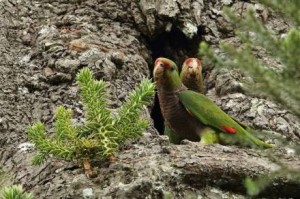Week 54 – 23 July 2017:
When Your Most Important Resource is a Hole
To a biologist, the Atlantic Forest of Brazil, Argentina and Paraguay is among the most enchanting places on the planet. In some parts of the forest, a single hectare of land may be home to more that 400 species of trees. Within the forest, among its myriad flowering plants, dwell uncounted types of mammal, amphibian, bird, and invertebrate animal. A very high proportion of those species dwell in the Atlantic Forest and nowhere else.
It was probably a pretty rosy place to live before humans started cutting it all down. Between forestry, agriculture and hunting, very little of the forest remains in its primordial state. Doesn’t that make the remaining segments all the more precious?
The Vinaceous-breasted Parrot is considered endangered by the IUCN. There are thought to be fewer than 2,000 mature individuals, with “a rapid and on-going population decline” probably resulting from “illegal nest poaching, habitat destruction and (its) persecution as a crop pest.” This parrot is an obligate cavity-nester, but its shares its home in Argentina with approximately 75 other cavity-nesting birds. An assortment of social insects and mammals also occupy cavities in trees in the region. As with so many other cavity-nesting birds, the Vinaceous-breasted Parrot doesn’t create its own cavity, but relies on excavators such as woodpeckers or wood decay. It appears that suitable cavities are rare, and this many limit the population of some species.
Eugenia Bonaparte and Kristina Cockle of the Instituto de Bio y Geociencias del NOA in Argentina sought to determine how much overlap there is between the types of cavities used by the Vinaceous-breasted Parrot and other cavity-dwellers. If conservation efforts are to be successful, it is best to know what sorts of cavities would most serve the endangered parrot, rather than one of its potential predators. Bonaparte and Cockle considered species overlap in the the timing of breeding and physical characteristics of cavities, and whether cavities are used by the same or different species in successive breeding attempts.
The study was conducted over ten breeding seasons in an area of mixed forest that included about 90% of the Argentine population of Vinaceous-breasted Parrots. The region contains unlogged forest, as well as pastures, cropland, and tree plantations. Beyond the parrots under study, cavities in the study area were used by birds such as Barn Owls, Saffron Toucanets, Barred Forest-falcons and White-eyed Parakeets, as well as opossums, bees and wasps.
Over the course of the study, Bonaparte and Cockle documented 78 tree cavities that were occupied by 153 nests and 16 roosts of birds, mammals and insects. The timing of breeding by the Vinaceous-breasted Parrot overlapped with almost all of the other cavity-nesting birds. Similarly, the characteristics of the trees and cavities used by the endangered parrots was similar to those used by most of the other birds, mammals and insects. Active nesting cavities were frequently reused by other species. Competition for this limited resource is likely.
In terms of the conservation and management of the endangered Vinaceous-breasted Parrot, it would have been nice if they had utilized cavities that were not attractive to their potential competitors. This wasn’t the case. Even though there was considerable overlap in the use of nest sites, Bonaparte and Cockle were able to identify characteristics of trees and cavities that could make them targets for special consideration. They suggested that the best situations are cavities between seven and 40 cm in diameter, at least 10 metres off the ground, in trees with a diameter of at least 55 cm. Given that a large proportion of parrot nests were found on farms, it will likely be prudent to work with farmers to help protect the most suitable trees.
Without those efforts, the Atlantic Forest might become a little bit less enchanting for the Vinaceous-breasted Parrot.
Bonaparte, E. B., and K. L. Cockle. 2017. Nest niche overlap among the endangered Vinaceous-breasted Parrot (Amazona vinacea) and sympatric cavity-nesting birds, mammals, and social insects in the subtropical Atlantic Forest, Argentina. Condor 119:58-72.
Photo credits: Vinaceous-breasted Parrots at nest, photograph © M. Lammertink , posted in an “Author Blog”, Auk and Condor, featuring Bonaparte and Cockle discussing their paper -americanornithologypubsblog.org/2017/01/18/cavity-nest-niche-of-the-endangered-vinaceous-breasted-parrot-sharing-a-limited-resource-among-birds-bees-and-opossums/; stamp featuring the Vinaceous-breasted Parrot – www.birdtheme.org



